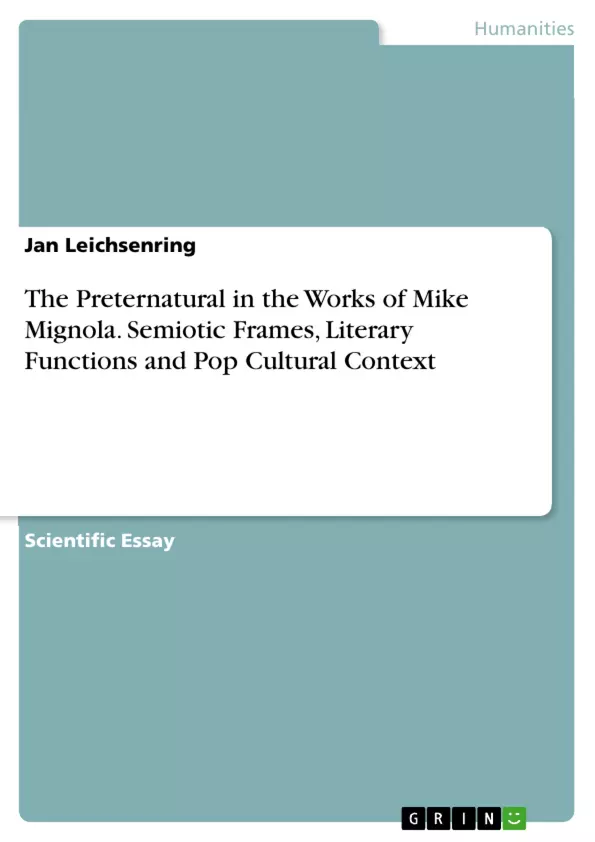This article explores the functions of the preternatural-themed images, how they are related to each other and in which general contexts of culture they are located. By doing so, it focuses especially on the works of Mike Mignola.
Mike Mignola is one of the most prominent writers and graphic artists in contemporary comics with a comprehensive œuvre particularly in the adventure/fantasy horror genre. In series such as Hellboy, on which the author will focus this article, he fuses the superhero tradition in mainstream comics with a large variety of narratives about the preternatural, combining elements of folk tales, mythologies, Christian figures of thought and last but not least the tentacle-armed Ancient Ones of H.P. Lovecraft.
Eventually, the story arcs and series are connected in the frame of a cosmological meta-plot. His protagonists are heroes in contact with the preternatural: some of them are preternatural beings themselves, while some are humans who gained knowledge about the preternatural and learned to deal with its dangers. Mignola’s narrative universe is not a very safe place, it is threatened by primordial powers. Types of the preternatural employed in these stories range from magical effects to cosmology, from transcendent spheres to metaphysics, and the artistic means of depicting the preternatural in its various shapes include stylistics of light literature and B-grade movies as well as pictorial language from classical cinema and modern avant-garde graphics. Moreover, the diachronical and synchronical contextualization of Mignola’s narratives pointing out the story elements discussed here go beyond their entertainment values and touch on basic cultural notions such as freedom of will, forms of sociality and ideas about the general character of the world.
Inhaltsverzeichnis (Table of Contents)
- Introduction
- Narrative Settings and Pop-Cultural Environment
- Types of the Preternatural in Hellboy and Lobster Johnson
- Fusing Christian Semiotics and the Superhero Tradition
- "It is for freedom that Christ has set us free."
- Liminal Characteristics and the Preternatural
- Retrofuturist Combinations of Secret History and Modern Age Mysticism
- Paranormal Phenomena and Abilities
- Fusing Christian Semiotics and the Superhero Tradition
- Framing Mythologies in a Cosmological Meta-Plot
- Inter-textual Reconciliation of Mythologies
- Biblical Aniconism in the Hellboy Narratives' Worldview
- Depicting the Multitude of the Preternatural in a Transmodernist Approach
Zielsetzung und Themenschwerpunkte (Objectives and Key Themes)
The paper examines Mike Mignola's use of the preternatural in his comic book series, focusing primarily on Hellboy. It analyzes how he incorporates these elements into his narratives, their connection to pop culture, and their implications for understanding social imaginaries. The paper also explores how Mignola's work contributes to the broader discourse on freedom of will, forms of sociality, and the nature of the world.
- The functions of the preternatural in Mignola's narratives.
- The connection between the preternatural and pop culture traditions.
- The use of Christian semiotics and the superhero tradition in Mignola's works.
- The exploration of social imaginaries through the lens of the preternatural.
- The relationship between freedom of will, sociality, and the nature of the world in Mignola's narratives.
Zusammenfassung der Kapitel (Chapter Summaries)
The introduction sets the stage for the discussion by introducing the main questions regarding the preternatural in Mignola's works and outlining the scope of the paper. Chapter 2 explores the pop-cultural environment that serves as the backdrop for Mignola's narratives, examining the evolution of superheroes and the incorporation of preternatural elements in comics, pulp fiction, and cinema. Chapter 3 dives into specific types of the preternatural found in Hellboy and Lobster Johnson, analyzing their semiotic functions and cultural context. This chapter further examines the fusion of Christian semiotics and the superhero tradition, as well as the role of retrofuturism and paranormal phenomena in Mignola's narratives. Chapter 4 explores how Mignola frames mythologies within a cosmological meta-plot, discussing the inter-textual reconciliation of mythologies and the impact of biblical aniconism on the worldview of the Hellboy narratives.
Schlüsselwörter (Keywords)
The primary focus of this paper is on the portrayal of the preternatural in Mike Mignola's comics, specifically Hellboy. The analysis draws upon key themes of pop culture, mysticism, mythology, metaphysics, and transmodernism to examine how these elements contribute to the broader social imaginaries and cultural contexts of Mignola's narratives.
- Quote paper
- Dr. Jan Leichsenring (Author), 2013, The Preternatural in the Works of Mike Mignola. Semiotic Frames, Literary Functions and Pop Cultural Context, Munich, GRIN Verlag, https://www.grin.com/document/984126



